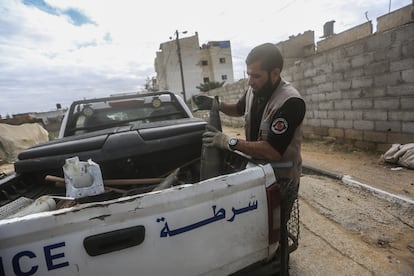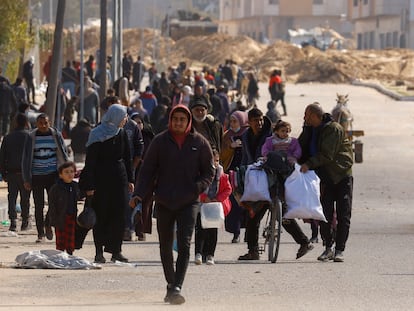Hamas weaponry: Made in Gaza
After most of its smuggling routes were cut off, Hamas resorted to making its own arms, partly by repurposing materials salvaged from Israeli attacks

The October 7 attack in southern Israel by Hamas’ armed wing, the Al-Qassam Brigades, stunned the world with its scale and sophistication. The group displayed surprising offensive capabilities, catching almost everyone off guard. Especially astonishing was the variety of weapons used by the militants to kill a staggering 1,200 people.
The densely populated and resource-poor Gaza Strip has been under a tight blockade by Israel and Egypt for over 16 years. It has endured multiple Israeli military operations and intense bombings with devastating effect. But all along, Hamas has been assembling a significantly larger and more advanced arsenal than everyone expected, including a wide range of rockets and light weapons.
Senior Hamas political and military officials claim that the majority of its weapons, including small arms, ammunition, rockets and other explosive devices are locally produced. Abu Obaida, the elusive spokesperson for the Al-Qassam Brigades, said in early January in a speech broadcast on Al Jazeera that all weapons used in combat are manufactured in Gaza, from bullets to rocket-propelled grenades and anti-tank systems.
“The way Hamas makes its weapons is somewhat of a mystery,” said a researcher from Calibre Obscura, a website about arms in the hands of non-state groups in the Middle East and North Africa. However, this researcher believes that the group has the capability to produce improvised explosive devices (IED), rockets, suicide drones and rocket launchers at the very least.
Al-Qassam weapons factories in Gaza are believed to rely heavily on repurposing materials salvaged from Israeli attacks on the region’s infrastructure, including homes and roads. A significant number of Israeli bombs and artillery shells dropped in Gaza do not detonate, enabling the group to extract explosive components and repurpose materials for their own rockets.
“Some [Hamas] weapons are smuggled in, but many have been locally manufactured,” said Gaza-based writer and analyst Ahmed Fouad Alkhatib, who has studied the group’s weapon-making capabilities. “Sometimes, that’s the only way they can get them.”

The Israeli Defense Force (IDF) army has also revealed Hamas’ local weapons-making capability several times during its ongoing military operation in Gaza. In mid-October, they shared a video on social media showing what they claimed to be homemade weapons used by the Al-Qassam Brigades in their October 7 attack. “Everything is homemade,” they said. In November, the IDF announced that it had killed a major Hamas weapons manufacturer. And in January, the IDF took journalists to see what it described as the largest weapons manufacturing complex discovered since the beginning of its war with Hamas. The IDF declined our request for information on similar findings.
Contraband and experience
A significant number of weapons used by Hamas, including bullets, pistols and grenades, are stolen from Israeli military bases and smuggled into Gaza or the West Bank, according to a recent IDF report obtained by The New York Times.
High-ranking Israeli politicians, including Prime Minister Benjamin Netanyahu, as well as some experts and research institutes, claim that a significant portion of Hamas’ weapons are smuggled into Gaza through tunnels from Egypt’s Sinai Peninsula. This is the only Gaza Strip border that Israel does not directly control. Analysts like Alkhatib say this smuggling is small in scale and only used to bring in precursor materials. Egypt denies this and claims to have completely sealed the border over the past 10 years after discovering a significant number of weapons crossing that border from 2011-2013.
“It’s basically a political ploy by Israel, another attempt to cover up their resounding failure against Hamas,” said Mohannad Sabry, an Egyptian researcher specializing in the Sinai region. “In recent years, Israel hasn’t been able to adequately assess Hamas’ evolution and increased military capabilities.”
The Gaza-Egypt border situation is sensitive as Netanyahu wants more control over the narrow passage between Sinai and the Gaza Strip, known as the Philadelphi or Salah al-Din corridor. However, Diaa Rashwan, the head of the Egyptian Information Service, dismissed claims of smuggling in a statement issued in late January. Rashwan accused the people making these claims of blaming external factors for their own mistakes.
Rashwan stated that as part of Egypt’s extensive anti-terrorism campaign in the northern Sinai over the past decade, 1,500 tunnels were destroyed, a five-kilometer buffer zone was established on the border, and the border wall separating Egypt from Gaza was reinforced. The Egyptian official also noted that “many” weapons in Gaza are “smuggled in from Israel.”
Iran acknowledges funding Hamas and training it to manufacture its own weapons. While Tehran also supplies arms to Hamas, the delivery channels are not well known. Egypt claims most smuggling occurs by sea, with clandestine shipments dropped miles off the coast of Israel-controlled Gaza. “In recent years, Hamas has relied on the technical expertise and manufacturing capabilities provided by Hezbollah and Iran to enhance their local production and employ different combat strategies,” said Alkhatib.
Recent investigations into the weapons used by Hamas in Gaza and Israel have identified that some were made in Iran, China, Russia, North Korea and Bulgaria. However, it’s unclear whether the governments of these countries actively supply Hamas with weapons, or if they were acquired on the black market.
Although Hamas has demonstrated greater military and arms manufacturing capabilities than previously estimated, the IDF is immensely more powerful. The Israeli army has killed over 27,000 Palestinians during the ongoing offensive in Gaza, as reported by the Hamas-controlled Ministry of Health in Gaza, which does not distinguish between combatants and civilians. In contrast, the armed Palestinian factions have killed 222 Israeli soldiers, according to the Israeli army.
Sign up for our weekly newsletter to get more English-language news coverage from EL PAÍS USA Edition
Tu suscripción se está usando en otro dispositivo
¿Quieres añadir otro usuario a tu suscripción?
Si continúas leyendo en este dispositivo, no se podrá leer en el otro.
FlechaTu suscripción se está usando en otro dispositivo y solo puedes acceder a EL PAÍS desde un dispositivo a la vez.
Si quieres compartir tu cuenta, cambia tu suscripción a la modalidad Premium, así podrás añadir otro usuario. Cada uno accederá con su propia cuenta de email, lo que os permitirá personalizar vuestra experiencia en EL PAÍS.
¿Tienes una suscripción de empresa? Accede aquí para contratar más cuentas.
En el caso de no saber quién está usando tu cuenta, te recomendamos cambiar tu contraseña aquí.
Si decides continuar compartiendo tu cuenta, este mensaje se mostrará en tu dispositivo y en el de la otra persona que está usando tu cuenta de forma indefinida, afectando a tu experiencia de lectura. Puedes consultar aquí los términos y condiciones de la suscripción digital.










































